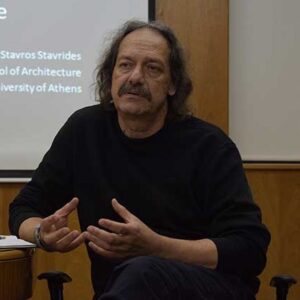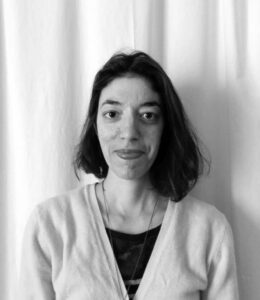Summary of the Research Proposal
The architecture of everyday life, the lived space, issues of gender, housing, and habitation were the main concerns and research interests in the personal, professional, and academic career of Annie Vrychea (1944-2005), professor of the NTUA School of Architecture. Starting from the defense of the right to the city, her research and realized work focused on the participation of users in the production of everyday-life spaces, in an effort to eliminate spatial exclusions and social discriminations.
Her innovative participatory design proposal for the regeneration of the refugee settlement of Thebes, her contribution to the Habitat IV conference, her multilayered research on gender issues, her struggles for rescuing the refugees housing units on Alexandra Avenue, among others, laid down new foundations, expanding the boundaries of architectural theory and practice.
How could we relate the approach of Annie Vrychea, the importance she gave to the places and times of daily life, and to gender issues to the current situation? By unraveling the thread of the professional and research activity of Vrychea, the proposed research aims to emphasize the sensitivity with which she approached the architecture of everyday life and the spacetime of everyday people. “In the generalized crisis of values, ideas and ideologies, […] where is architecture? That is, poetry in our daily lives, in our city, in our cities, in our neighborhood? ” (Vrychea 1993) Starting with that question of Vrychea herself, which remains relevant, one target of this research is to study how her approach to the architecture of everyday life can contribute to the discussion of contemporary urban issues. An equally important objective is to focus on Vrychea’s gender perspective in the habitation of everyday-life spaces, while highlighting the often underestimated and overlooked female presence in architectural and urban research and practice.
Initially, the research group will study the primary sources from the archive of professor A. Vrychea, located in Department III (Architectural Language, Communication and Design) of the School of Architecture of the NTUA, to fill a significant gap that currently exists in understanding the importance of the architecture of everyday life. With the aim of bringing to light her theoretical and implemented work, the classification, digitalization, and study of the archives will result in the making of a catalog that can assist a future creation of a digital online archive, open and accessible to researchers, students, and teaching staff, ultimately expanding educational possibilities, easing access to hidden- and knowledge.
Research: “Architecture as everyday life poetics: The spaces and rhythms of the everyday through the archive of Annie Vrychea”
Research Team: Stavros Stavrides, Sergios Strigklogiannis, Ernestina Karistineu-Efthimiatu
The research project “Architecture as everyday life poetics: The spaces and rhythms of the everyday through the archive of Annie Vrychea” was funded by the Research Centre for the Humanities (RCH) for the year 2022.
Extended Summary
The architecture of everyday life, the lived space, the collective memory, issues of gender, housing, and habitation were the main concerns and research interests in the personal, professional, and academic career of Annie Vrychea (1944-2005), professor of the NTUA School of Architecture. Starting from the defense of the right to the city, her research and realized work focused on users’ participation in the production of everyday-life spaces, in an effort to eliminate spatial exclusions and social discriminations. Her innovative participatory design proposal for the regeneration of the refugee settlement of Thebes, her contribution to the Habitat II conference, her multilayered research on gender issues, and her struggles for rescuing the refugees housing units on Alexandra Avenue, among others, laid down new foundations, expanding the boundaries of architectural theory and practice. At this point, a question that inspired our research arose:
How could we relate the approach of Annie Vrychea, the importance she gave to the places and times of daily life and to the collective memory, to the current situation?
By unraveling the thread of her research and implemented works, this study rediscovered through revisiting her archive, the importance and the agency of the architecture of everyday life in contemporary cities. The exploration of the archive was conducted with various methodological tools: interviews, the creation of a catalog, on-site fieldwork, and of course the actual study of the found archival documents, a fact that revealed really important details regarding her sensitive approach in various research projects, practices and in her teaching philosophy:
Firstly, the material in relation to the regeneration of the refugee settlement of Thebes manifests her belief that the connection point between the architecture of everyday life and spatial justice is the community participation in co-shaping its own spaces. The effort to include the users in the decision-making processes along all phases of the design was, and still is, an alternative practice that contrasts the established top-down design policies.
Secondly, in many of the research programs that she participated as a member of EUROPIL (European Federation for Integration and Promotion through housing), but also in her writings for Habitat II or the initiative for the creation of an ‘Archive for Poor Housing’, the archival documents reflect special attention towards meticulous documentation of the everyday life practices in neighborhoods “in crisis”. This analytic process, incorporating a variety of methods, from photographic documentation to detailed drawings and notes, and interviews with the inhabitants of the areas in question, is constantly described as a vital step in the direction of the design and planning proposals. Aspects of her working approach reflect her commitment to social and spatial justice starting from the involvement of the most vulnerable and marginalized groups of the community, in the belief that a design that fulfills their needs won’t fail in creating neighborhoods and everyday-life spaces suitable for all.
Thirdly, throughout her work, the re-discussion of the community’s involvement goes hand in hand with questioning the ‘mythical’ role of the expert. For Vrychea, the challenge was not to search for a new role for the architect, but rather for a new user/specialist relationship, which would produce more inclusive spaces from those defined by the narrow market context and would strengthen the character of neighborhoods and cities as a common good. As can be seen in the contents of the archive, the detailed documentation of the practices and traces of daily life in areas in “crisis” – starting from the scale of objects to the scale of neighborhood and city – is always described as the basis and the essential condition for any idea about their transformation. Each design proposal – should function as a gesture of “protection” for them, as a field of valuable social wealth.
Fourthly, the participation of women was crucial for Vrychea, for their role both, in the private and public realms. In various projects and in her teaching approach, we encounter a continuous focus on the ingenuity and creativeness of the habitation of women, their everyday practices, and diverse ways of transforming the spaces in which they inhabit. The latter went hand in hand with an exploration of new methodological tools with which architecture could enrich its practices in order to take into account the gender perspective.
In conclusion, this research through the revisitation of the archive of Professor Annie Vrychea, which constitutes an important witness of her alternative theoretical approach to space, her ideas, and her beliefs, proved that the value of the archive lies in its relevance to contemporary urban issues. Therefore the rediscovery of Vrychea’s approach, on one hand, filled a significant gap that currently exists in understanding the importance of the architecture of everyday life, and on the other brought into light important methodological tools and theoretical frameworks for the making of more just cities.
An indirect but equally important outcome that this research managed to achieve, is to highlight the often underestimated and overlooked female presence in architectural and urban research and practice. Throughout her career, Vrychea always supported women’s participation in physical, social, and political environments. Recognizing that the architectural and academic spheres are mostly representing and reproducing men’s contributions, this research wishes to contribute to the passing of her legacy to future generations of architects.
Finally, the present study aims to act as a trigger, a reminder, and an invitation for young researchers to visit the archive. This invitation was created with the expectation of preserving and updating the urgent debate that the work of Vrychea established around the connection of the study of space and the practices of its transformation in the field of architectural studies through her interdisciplinary, detailed, and socially sensitive approach to the architecture of everyday life.
The full academic report for this research’s results is available in Greek. To view it, click here and browse to the tab “Αποτελέσματα Έρευνας”.
 Dr. Stavros Stavrides, architect and activist, is Professor of Architectural Design and Theory at the School of Architecture, National Technical University of Athens Greece, where he teaches graduate courses on housing design (including social housing), as well as a postgraduate course on the meaning of metropolitan experience. He has published numerous articles on spatial theory. His books: The Symbolic Relation to Space (1990), Advertising and the Meaning of Space (1996), The Texture of Things (with E. Cotsou, 1996) From the City-Screen to the City-Stage (2002, National Book Award), Suspended Spaces of Alterity (2010), Towards the City of Thresholds (in English, 2010 and 2019, in Spanish and Turkish 2016), Common Space (in English, 2016, in Greek 2018, in Turkish 2018) and Common Spaces of Urban Emancipation (in English 2019). His research is currently focused on forms of emancipating spatial practices and spaces of commoning.
Dr. Stavros Stavrides, architect and activist, is Professor of Architectural Design and Theory at the School of Architecture, National Technical University of Athens Greece, where he teaches graduate courses on housing design (including social housing), as well as a postgraduate course on the meaning of metropolitan experience. He has published numerous articles on spatial theory. His books: The Symbolic Relation to Space (1990), Advertising and the Meaning of Space (1996), The Texture of Things (with E. Cotsou, 1996) From the City-Screen to the City-Stage (2002, National Book Award), Suspended Spaces of Alterity (2010), Towards the City of Thresholds (in English, 2010 and 2019, in Spanish and Turkish 2016), Common Space (in English, 2016, in Greek 2018, in Turkish 2018) and Common Spaces of Urban Emancipation (in English 2019). His research is currently focused on forms of emancipating spatial practices and spaces of commoning.
http://courses.arch.ntua.gr/stavrides.html?i=125566
 Sergios Striglogiannis is an architect, graduated from the Universität Stuttgart, he obtained a postgraduate degree from KU Leuven (M.Sc. in Human Settlements), and he is currently a Ph.D. candidate at the National Technical University of Athens, Sector 3 – “Architectural Language, Communication and Design”. His research interests focus on urban commons, participation, and the re-appropriation practices of urban space, with an emphasis on urban art. As a Ph.D. candidate, he has been a teaching assistant at various undergraduate classes of the School of Architecture of the N.T.U.A. and has participated in international conferences and workshops.
Sergios Striglogiannis is an architect, graduated from the Universität Stuttgart, he obtained a postgraduate degree from KU Leuven (M.Sc. in Human Settlements), and he is currently a Ph.D. candidate at the National Technical University of Athens, Sector 3 – “Architectural Language, Communication and Design”. His research interests focus on urban commons, participation, and the re-appropriation practices of urban space, with an emphasis on urban art. As a Ph.D. candidate, he has been a teaching assistant at various undergraduate classes of the School of Architecture of the N.T.U.A. and has participated in international conferences and workshops.
 Ernestina Karistineu Efthimiatu was born in Athens and grew up on Naxos. She studied architecture (Department of Architecture-University of Patras, 2012), and currently is a Ph.D. candidate at the National Technical University of Athens, School of Architecture (Department III Architectural Language, Communication and Design), on the subject of “Photographic Representations of exile: body and space”. Her research explores the ways in which photographic documents construct the image of the exile space in the context of formal and informal photographic archives, focusing on Greek exile islands Trikeri and Yaros.
Ernestina Karistineu Efthimiatu was born in Athens and grew up on Naxos. She studied architecture (Department of Architecture-University of Patras, 2012), and currently is a Ph.D. candidate at the National Technical University of Athens, School of Architecture (Department III Architectural Language, Communication and Design), on the subject of “Photographic Representations of exile: body and space”. Her research explores the ways in which photographic documents construct the image of the exile space in the context of formal and informal photographic archives, focusing on Greek exile islands Trikeri and Yaros.
She holds a MA degree in “Architectural Design – Space – Culture” from the National Technical University of Athens. She has worked as a freelance architect, as a children’s educator on architectural heritage and has been a teaching assistant in the School of Architecture. Her research interests include areas where the theory of habitation of space and habitation of image meet, space in the context of “state of exception” and archival research.
